Art in Mind the Contribution of Contemporary Images to Thought

Yayoi Kusama, "Yellow Pumpkin," 1994 (Stock Photos from Adam Rifi/Shutterstock)
To many people, coming up with acontemporary art definition can exist a tricky task. While its title is simplistic and straightforward, its modern-day meaning is not as articulate-cut. Fortunately, understanding what constitutes as "gimmicky" is entirely possible in one case one traces the concept'due south history and explores its underlying themes.
What is contemporary art?
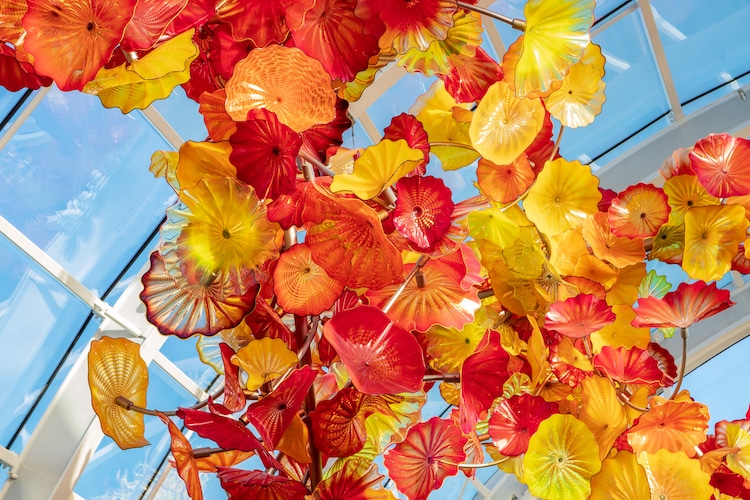
Chihuly Garden and Glass in the Seattle Centre (Photo: Stock Photos from ApinBen4289/Shutterstock)
In its most basic sense, the term contemporary fine art refers to art—namely, painting, sculpture, photography, installation, performance, and video art—produced today. Though seemingly simple, the details surrounding this definition are oftentimes a chip fuzzy, as different individuals' interpretations of "today" may widely and wildly vary. Therefore, the exact starting point of the genre is still debated; however, many art historians consider the late 1960s or early on 1970s (the end of modern art, or modernism) to exist an acceptable estimate.
History: Major Contemporary Fine art Movements and Artists
Given its "fine art of today" definition, you may be surprised to hear that contemporary fine art actually has a relatively long history. To trace its evolution, permit's accept a look at the major movements and of import artists that etch its history.
Pop Fine art

Andy Warhol, "Flowers" (Photo: Stock Photos from Radu Bercan/Shutterstock)
Intended equally a reaction to preceding mod art movements, contemporary art is thought to have begun on the heels of Pop Fine art. In post-war United kingdom and America, Popular Art was pioneered past artists like Andy Warhol and Roy Lichtenstein. It is defined by an interest in portraying mass civilization and reimagining commercial products as accessible fine art. While the movement lasted roughly from the 1950s through the early on 1970s, it was reborn as Neo-Pop Fine art in the 1980s cheers to artists like Jeff Koons.
Photorealism
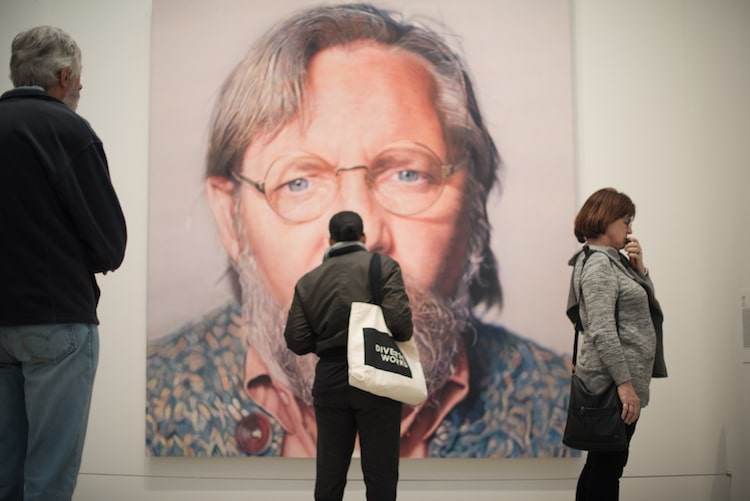
Portrait of Chuck Close (Photograph: Stock Photos from Rushay/Shutterstock)
Much like artists working in the Pop Art way sought to artistically reproduce objects, those involved with Photorealism—a concurrent movement—aimed to create hyperrealistic drawings and paintings. Photorealists often worked from photographs, which enabled them to accurately reproduce portraits, landscapes, and other iconography. Chuck Close and Gerhard Richter frequently worked in this manner.
Conceptualism
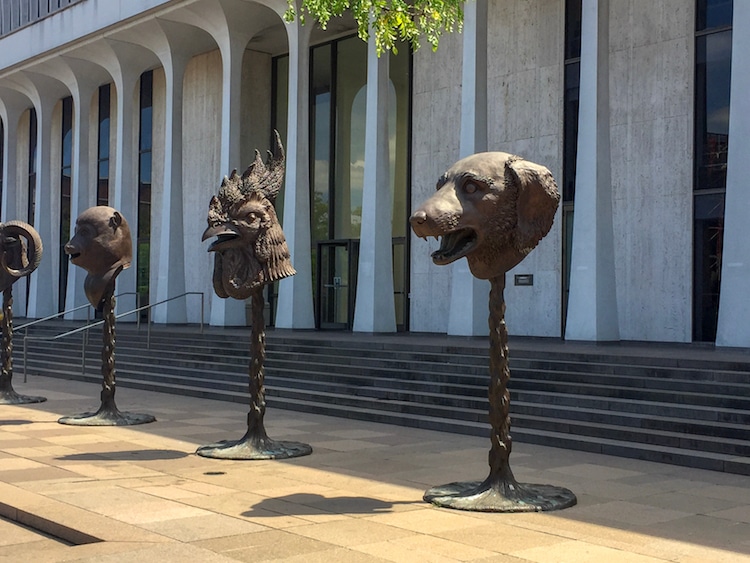
Ai Wei Wei, "Circle of Animals/ Zodiac Heads," 2010 (Photograph: Stock Photos from Alisa_Ch/Shutterstock)
In turn, Pop Art also helped shape Conceptualism, which rejected the thought of fine art as a article. In conceptual fine art, the idea behind a work of art takes precedence. Major conceptual artists include Damien Hirst, Ai Wei Wei, and Jenny Holzer. Though this experimental motion is rooted in art of the early 21st century, it emerged as a formal motility in the 1960s and remains a major contemporary art movement today.
Minimalism
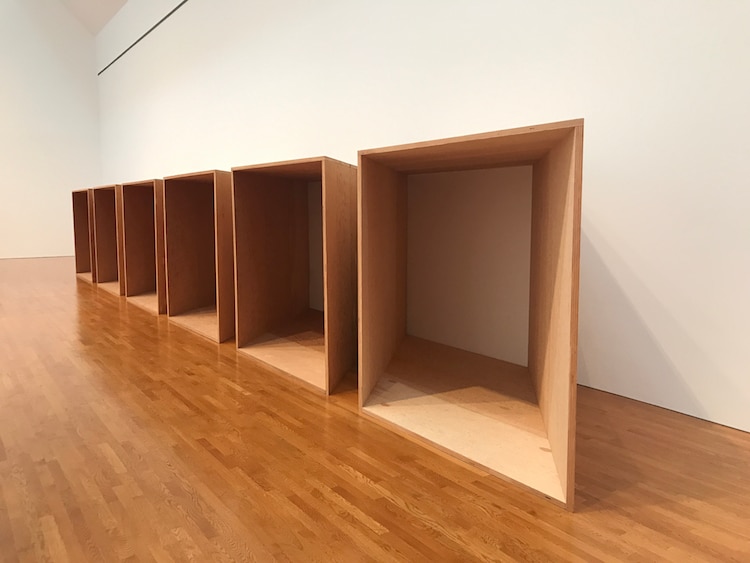
Donald Judd, "Untitled," 1973 (Photo: Stock Photos from Todamo/Shutterstock)
Like Conceptualism, Minimalism materialized in the 1960s and is still prevalent today. According to the Tate, both movements "challenged the existing structures for making, disseminating and viewing art." What sets Minimalism autonomously, however, is that its uncomplicated, abstruse aesthetic invites viewers to reply to what they see—not what they think a given work of art represents. Donald Judd, Sol LeWitt, and Dan Flavin are some key Minimalist artists.
Performance Fine art
Another movement with Conceptualist roots is Performance Art. Beginning in the 1960s and retaining its popularity today, functioning art is a drama-inspired approach to art. While the art form is performed by artists (as the name suggests), it is not solely intended equally amusement. Instead, its goal is to convey a message or thought. Predominant performance artists includeMarina Abramović, Yoko Ono, and Joseph Beuys.
Installation Art
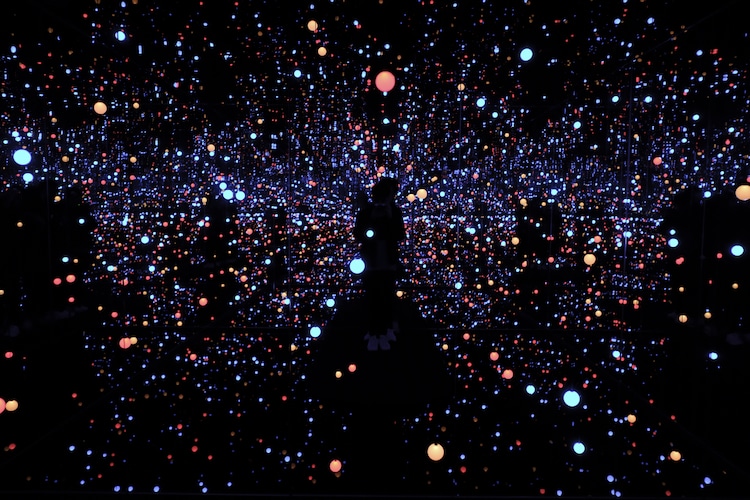
Yayoi Kusama, "Gleaming Lights of the Souls," 2008 (Photo: Stock Photos from ephst/Shutterstock)
Similar functioning pieces, installation fine art is an immersive medium of art. Installations are three-dimensional constructions that transform their environment and alter viewers' perceptions of infinite. Oftentimes, they're large-scale and site-specific, enabling artists to transform whatsoever space into a customized, interactive surroundings. Well-known installation artists include Yayoi Kusama,Dale Chihuly, and Bruce Munro.
Globe Art
A unique spin on installation art, World Art (or Land Art) is a move in which artists transform natural landscapes into site-specific works of art. Robert Smithson, Christo and Jeanne-Claude, andAndy Goldsworthy are celebrated for their avant-garde excavation.
Street Art
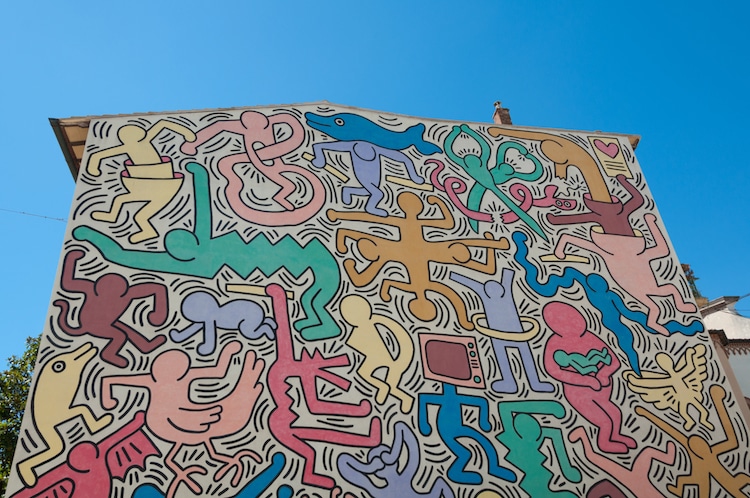
Keith Haring, "The Pisa'southward Mural, 1989 past Stock Photos from peepy/Shutterstock
As one of the most recent contemporary fine art movements, street art is a genre that gained prominence with the rising of graffiti in the 1980s. Often rooted in social activism, street fine art includes murals, installations, stenciled images, and stickers erected in public spaces. Primal street artists include figures from the 1980s, like Jean-Michel Basquiat and Keith Haring, as well every bit practicing artists like Banksy andShepard Fairey.
Contemporary Art and the Digital Age
Contemporary fine art is continuously evolving and more artists are taking advantage of new applied science to further their inventiveness. This includes code-generated art, which can produce everything from abstract pieces to futuristic vector portraits. As advances in artificial intelligence continue, some artists are using the engineering to create hyperrealistic portraits that test the boundary between reality and imagination.
Crypto art , which takes advantage of blockchain technology, has been picking up steam since 2020. With digital creative person Beeple making a landmark $69 million sale at Christie's with his NFT collage, more artists and fine art institutions are seeing the possibilities in this form of art. Crypto art is allowing digital artists to monetize work that may accept been previously hard to sell. The nail in NFT art is allowing artists who create imperceptible pieces— whether installations, performances, or murals—to be compensated and collected in a style that was previously unheard of.
What'south Next for Contemporary Art?
While some of the artists we've looked at are either no longer alive or unable to practice, many aforementioned greats, including—simply not limited to—Damien Hirst, Ai Wei Wei,Marina Abramović, Yayoi Kusama, and Jeff Koons, proceed to create avant-garde works of painting, sculpture, installation, and performance art.
In addition to these famous figures, many upwardly-and-coming contemporary artists are stunning the world with their original approach to fine art. On top of putting their own twists on conventional forms like painting, sculpture, and installation, they've also popularized unexpected forms of fine art, like embroidery, origami, and tattoos, proving the endless possibilities of the all-encompassing genre.
This article has been edited and updated.
Related Manufactures:
ten of the Best Gimmicky Fine art Museums to Visit Around the World
12 Gimmicky Artists Tell Us What information technology Takes to Make a Great Slice of Fine art
vi of the Best Modern Art Museums in the World
Source: https://mymodernmet.com/what-is-contemporary-art-definition/
0 Response to "Art in Mind the Contribution of Contemporary Images to Thought"
Postar um comentário